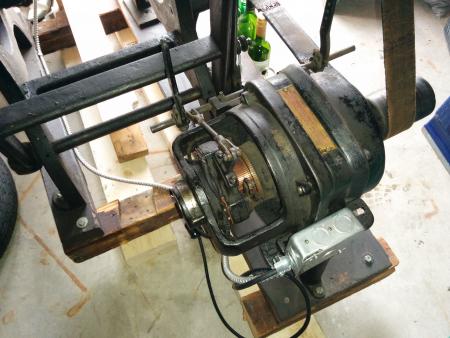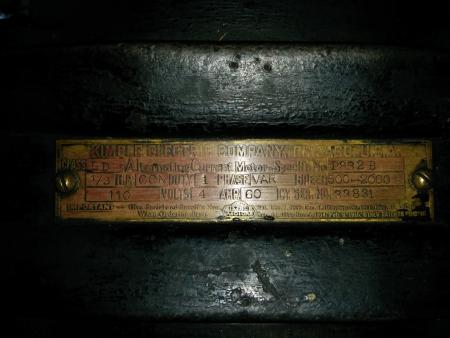Kimble brushes needed
So I’ve gotten a Challenge Gordon 8x12 with a Kimble motor attached. The motor needs new brushes. Does anyone know the specs for the brushes so I can get a pair made?
I’ve attached he’d a picture of the motor and the plate describing the type of motor
Thanks!

IMG_20160330_084525.jpg

IMG_20160330_084534.jpg
Make SURE you have disconnected ANY and ALL power to the press before messing with these…(USE VOLT METER)
do you have absolutely nothing left of old brushes? these brushes most likely can be found “off the shelf” some sort of width by height are needed.
the “slot”; “guide bracket”,or “seat” they fit into can be measured. length can be assumed. (they prob have some common dimensions like; 1/4” x 1/2”, 3/8” x 3/4”, or something) you will also need to know what type and length of shunt (connecting wire with connection) is there.
you can contact me as i have looked for brushes before, and have some contacts for them.
When the brushes are suspect, this usually is only half the problem. The stator, or armature needs close inspection as once arching has been occurring, both sides of the electric contact circuit get burned.
I have absolutely nothing to work with. I’m assuming that the brushes would fit into the place that I’ve taken a picture of. Am I right? If so the space is 1/2” x 1” and about an inch from the copper looking area below. This is all I got.
IMG_20160330_140816~2.jpg
IMG_20160330_140821~2.jpg
okay. yes, that is the “brush seat”. that spring loaded thing is the retainer. it pushes the brush against the armature, which in this case looks good. it looks like you possibly just have brushes there with no shunt. it almost looks like the retainer is the contact.
what is distance between the top of this slot looking bracket and the copper stator?
is 1/2 by 1 the inside, slot, dimension?
it looks like a wire is looped kinda loosely to the retainer in the top pic? is that electrical? or is it for pulling ope the retainer.
Ok…looking at bottom pic, that yellow piece touching the copper stator is about 1” and square.
Looking at top pic, that rectagluar “slot” is 1/2” x 1”.
I thought brushes were made of carbon. Is that right? If so, I don’t see anything that resembles that.
The wire is not connected to this…I think that’s just the angle of the picture.
In case you go to a motor shop to get brushes, you should probably know the correct terms so you don’t confuse them.
The motor has two main parts. The stationary part (inside the housing), is called the stator. The rotating part is called the armature. On the armature, the bare copper area with all the segments which the brushes contact, is called the commutator.
And yes, the brushes are made of carbon, which is a dark gray or black color.
ok, thanks Geoffrey, it must be a regional thing. around here, the words, stator and armature are used interchangeably, we call the outer fixed magnets “field” magnets.
I will start digging into suppliers..
this is not a brush related question. in the very first picture I see couple green bottles with white labels. are they part of the press’s alcohol dampening system?
Louie
http://eagleprint.ca
LOL!!!!! Busted! I was hoping no one would notice those…
Eric and Geoffrey….thanks so much for your help. :)
TriciaMc, The Commutator on your motor is in bad shape.
Replacing the brushes with out having the communtator,turned on a lathe is pretty much a waste of time. Look up a place that specializes in electric motor repair in your area and take the
motor to them. best james
Corroborating all of the above, and re J.B.s *state of the Commutator* yes from a technical point of view, relatively in bad shape, because if and when new brushes are fitted, with that amount of concave wear, new brushes are perfectly square on the working face and have to *Bed In* to match the curvature of the commutator, new brushes will initially and for some time (running hours) Sit on top and encourage Arcing and more problems.
As J.B. implies,! have it turned down, but 2 important Points,It the commutator has circumference Limits for the amount that can be turned Off, . . From your last shot seeing the original unworn segments (far Right) it would appear that it (Comm.) has never been turned down, by implication good news.
2ND. point pick a reputable Machinist, (word of mouth preferably) because,with all the will in the world, all may do a comparable job,? there is such a massive cross section of different sizes, there is NO SUCH thing as a TOOL to undercut the “swarf” and “burrs” between the segments caused by the *Turning* the genuine Engineers merely grind up an ex Hacksaw blade with a tiny hook, exactly the width to undercut and clean up, and should not Charge EXTRA for a special purpose tool.
The above has been standard practice here U.K. back many years on Motors as small as Your *Kimble* up to and including 5-10 Horse Power motors from Heidelberg Cylinders..Etc.
For many years I was the *Grease Monkey* who hauled H/berg, motors out on a Friday Mid day,!. took them to the Machine shop Friday afternoon, collected Saturday Mid day refitted Sat/Sunday, (on double time of course) so that the Machine,s were ready to Roll Monday, 6 A.M. on double Day Shift. >>Until Litho sold us down the River.<<
O.K.(it is too late now for any repercussions) but did work in, the odd little *Rush Job* boring the Cylinder Barrels or grinding the Crankshaft on the *Triumph Thunderbird* paid Cash at preferential rate, with no Bill of sale, etc.
More info from the *Old* Horses mouth, if needed, via B.P. lines of communication.! . . Good Luck.
TriciaMc, The look of the commutator it needs work or at least undercutting the segments. A proper seating of the brushes is needed on these older motors to reduce the damage that can be caused by not shaping the brushes as others have stated arcing damage. Some newer brushes are also impregnated with a copper these should not be used on the older machines.
Hope you get it going.
John
Do you think the motor is worth saving? Or should I just get a new one or put the treadle back on (assuming I can find one).
Here’s my take on it.
Cons: 1) it’s an old motor. 2) the commutator is worn. 3) there may be other things wrong with the motor such as bearings.
Pros: 1) there seems to be little if any evidence of arcing at the commutator in the past. 2) the commutator is in pretty good condition considering its age. 3) the bearings are probably all right (grab the pulley end of the shaft and try to move it sideways and up and down….there should be little movement). Keep the bearings oiled. 4) when in working order, it is a simple way to get variable speed for your press
Probably the best thing to do would be to take it to a motor shop, and try to find a shop which has been in business for a long time (e.g. “established in 1932” or similar. (You might have to visit a few shops and get a feel for their attitude regarding fixing old motors. Bring a few pictures of the motor with you). I’m sure there will be shops which are willing to work on it. They will turn the commutator in a lathe or grinder, clean out the spaces between the commutator segments, put the right brushes in, check and replace the bearings if necessary, and generally overhaul it. Then you will have a motor which, assuming you aren’t running it 40 hours per week, should be good for your lifetime.
the new motor would not clash with the wine bottles beside the press, but it would be a shame not to preserve the original motor. as Geoffrey said, it looks like it is is in a pretty good shape, it deserves to be restored.
a while back, on my Heidi’s motor the centrifugal switch and/or the capacitors were gone. I had to crank the flywheel with gloved hands before I turned the power on. when I went to the motor shop, they laughed at me as if I was from the movie: Back to the Future. they had boxes and boxes of old type switches, but not the particular one I needed. they suggested to bring in the motor, to install solid state switch, or to replace the motor … etc.
I kept on looking at all those boxes of switches laid out on the bench. how much is for that one, I sad. it was $10 and I had to re-drill two mounting holes on it to fit and ever since that my Heidi is happily starting on his own. I changed the two capacitors too.
so, you never know, sometimes you get lucky !
Louie
http://eagleprint.ca
Tricia, One more possibly over-riding factor which may influence replacing or not replacing the motor, (of course staying traditional and original is always a good point for posterity) but in this day and age *Cost* may be the governing factor.!!
*****
From your very first published picture, it is virtually certain that the tiny ball ended lever, (vertical) is the means to advance and retard the brush assembly in relation to the commutator, (for speed control)
This the crudest form of speed control from way back,
BECAUSE in fully advanced mode, synonymous with fastest machine speed (I.P.H.) it is pulling the least amount of current and clocking up *fairly* modest amount of electricity.
In fully retarded Mode, synonymous with slow hand feeding, the amount of current being pulled, and the amount of electricity consumed, goes >>through the roof<< and puts substantial extra load on the supply cables… **** See below.
Although it would be desireable and almost necessary to have some form of speed control, COST may be the governing factor, I.E. new complete system OR refurbish the original, and stand the cost of the electricity.
****Quoted from Hard earned experience, I.E. used an English, “British Thompson Auto Platen” close relative of the Heidelberg, eventually, but not soon enough, worked out the syndrome as above, old Analogue electricity meter with visible Unit wheel would CREEP when fully advanced,?? (top speed with the right stock up)
When fully retarded, the Unit wheel would FLY at many revs per hour, Soon as practical reverted to modern fixed speed motor and utilized the Coned Pulley and Belt from Heidelberg Platen.
This precise system, with slight variations, and modern fixed speed motor, has been posted on B.P. fairly recently, and with a little trawl of the Web, several Videos 5-10 minutes, mostly Stateside?? depicting proud owners demonstrating their systems, some a little Dodgy,
****
No alcohol damping, Nice one Louie,
****
Just lots of sparks from the COMMUTATOR??? check it out perhaps.
Key in to Google, Chandler & Price printing press running, stand back from the screen, turn the sound down, Watch, Listen,?? it is probably even a Kimble motor and the buzzing on start up is probably indicative of the same problem as yours in early stages. and the Brush gear should NOT be exposed, especially with “Alchohol” damping close at hand.
Good Luck, Mick
i
i have found brushes i believe will work for this. you take it from there as to which of these posts you want to follow. it would be prudent to figure if bearings are good. about $50.00(US) a piece includes shipping.
Where did you end up getting brushes from?